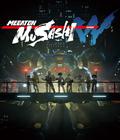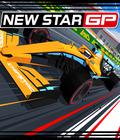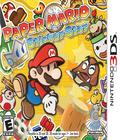Paper Mario was originally born as a spin-off of the Squaresoft title Mario RPG, but it has since evolved into its own franchise. Paper Mario is set in a version of the Mario world where everything — the world, the people, etc. — is made of paper. This means that there is some classic Mario-style platforming and unique mechanics that take advantage of Mario's wafer-thin state. The previous game in the series, Super Paper Mario, cut out most of the RPG elements in favor of a more traditional platforming game. Paper Mario: Sticker Star is a return to form for the franchise, though it's not quite the same as Paper Mario: The Thousand Year Door.
In Paper Mario: Sticker Star, Mario is visiting the Princess Peach during a festival that celebrates stickers. A massive sticker comet is passing overhead, and the paper people of the Mushroom Kingdom are throwing a celebration. Of course, Bowser shows up and ruins everything. He crashes into the sticker comet and steals the royal stickers, which are powerful stickers that grant him near-invincibility. He beats the living daylights out of Mario, kidnaps the princess, and takes off. Mario has to collect the scattered royal stickers to stand a chance against Bowser's evil.
Paper Mario: Sticker Star is closer to Paper Mario than it is to Super Paper Mario, but there are similarities to both games. The game is divided into a single hub world (Decelberg) and a large world map that you can use to travel to the available worlds. These worlds are divided up into smaller levels, Mario-style, right down to being named World 1-1, 1-2, etc. In each area, your goal is to find a piece of the sticker comet. Some may be found by completing puzzles, others can be acquired by defeating bosses, and others may be attained by navigating mazes. There are even levels with two comet pieces, each of which unlocks a new path and a new level.
As for your exploration abilities, you can walk and jump. You also have a giant hammer to smash walls and objects, often allowing you to find hidden paths or enemies. Your most important abilities involve stickers. There are different kinds of stickers that you can use to alter the world by using the Paperize ability, which allows Mario to freeze everything for a moment and add or remove stickers to the area. You may encounter a windmill that won't move, but finding and using a fan sticker creates a giant wind to start it up. You may find someone's flower garden utterly wrecked and use your fire flower and ice flower stickers to fix it. You can even use more generic stickers to block fans or fix holes in the wall. Most of the puzzles involve manipulation of stickers, and there are times you won't be able to advance unless you go to another level and find a sticker that was previously unavailable.
Paper Mario's battle system is similar to the RPG-style combat seen in the two original games, although there are some significant differences. For one thing, the game has done away with regular attack commands. Instead, your attacks are determined by stickers that you collect in the world. Jump stickers let you jump on enemies, Hammer stickers allow you to pound them with your hammer, Fire flower stickers spam fireballs at unlucky enemies, and so on. Each sticker is a single-use item since you can't really reuse stickers. This means that your attacks are limited to the stickers you have, and your stickers are kept in an album that has limited space. You begin with two "pages" and can unlock more, but that still leaves you somewhat limited. Stronger stickers take up more slots, and you can even create special stickers by finding rare non-paper objects and taking them to a craftsman who converts them into stickers.
Each sticker has attributes and effects that can be amplified by the traditional Mario RPG-style active combat system. When you use a sticker, you have a brief period in the animation during which you can press a button. Press your button at the right time, and the attack does extra damage and gains additional effects. The basic hammer, for example, requires you to "charge up" before you strike. Time it correctly, and you'll do more damage and hit multiple enemies at once. Time it incorrectly, and the head falls off, causing Mario to hit the enemy with a weak attack.
Various enemies react in different ways to different attacks. Use a jump attack on a Koopa Trooper, and you'll knock it into its shell. Use one again, and you'll knock it into every enemy behind it for massive damage. This even carries over to boss fights. The first boss is a giant Goomba formed from many smaller Goombas. He has a ton of hit points and hits like a truck. You can beat him normally, although it involves proper management of items. Alternately, you can find a special scissors sticker. When the monster Goomba reveals its weak point during a single attack, you can use the scissors to separate the smaller Goombas, leaving the poor monster vulnerable to an easy thrashing.
Another twist to the system is that the traditional Paper Mario partners are sadly absent. In their place is a new Battle Spinner system. At any time, you can spend three coins for a chance to play a game of slots. Match two icons, and you'll unlock the ability to use two stickers in the same turn. Match three icons, and you'll hit the jackpot: three stickers in one turn, two stickers in the next turn, and a special bonus determined by the icon you matched. Match three mushrooms, and you'll get a free burst of healing. Match three coins, and you'll get extra cash. This isn't optional, as certain enemies require that you get at least two attacks to effectively damage them. An early boss in the game is only vulnerable to damage when he's knocked on his back, but he'll always spend his turn getting up, so you'll need at least two turns to damage him.
Some thought has been put into the combat system. Winning battles effectively earns you more cash to spend on more stickers. If you're clever, there are a few ways you can squeeze extra cash out of fights. Finishing a battle without taking any damage gets you a Perfect Fight reward. You can also "overkill" enemies to earn extra cash. If you stomp on a Goomba who is low enough on health to be defeated, repeated stomps with the same sticker nets you a few coins. Coins are quite important, as they're your most reliable way to replenish stickers without having to replay stages to find them. You also need them to fuel the Battle Spinner and do the most damage possible to bosses.
It should be noted that there are no experience levels in Paper Mario: Sticker Star. In fact, there are no stats aside from HP. You can't gain levels in the way that you would in other games, and you can't grind to increase your abilities. Stickers get more powerful as the game progresses, but you'll find that jump is as powerful early on as it is later. The only way you can alter Mario's basic stats is by finding HP-increasing items scattered throughout the world. They're usually found in hidden areas or given as rewards for side-quests. This also means that grinding isn't a necessity, either. If you are fighting an enemy, you can beat it. You may need to change the stickers you're using or rethink your tactics, but you can take it down. You can also avoid enemies if you'd like, limiting the amount of fights in the game.
Paper Mario: Sticker Star looks to be another solid addition to the Paper Mario franchise. After the more action-oriented Super Paper Mario, it returns to its roots in many ways. It retains much of the charm in previous games while adding its own sense of style. Longtime fans may lament the loss of the series' trademark partners or the more traditional leveling system, but there is still much to like here. The new combat system and cheerful world have the potential to be among the series' best yet. Paper Mario: Sticker Star is due Nov. 11 for the Nintendo 3DS.
More articles about Paper Mario: Sticker Star










 On the day of the annual Sticker Fest, Bowser pulls a prank and scatters six Royal Stickers across the land. To retrieve these mysterious, magical stickers, which are now stuck onto Bowser and his underlings, Mario sets off on an adventure with Kersti, a sticker fairy, visiting prairies, deserts, forests, snowy mountains and volcanoes around the world.
On the day of the annual Sticker Fest, Bowser pulls a prank and scatters six Royal Stickers across the land. To retrieve these mysterious, magical stickers, which are now stuck onto Bowser and his underlings, Mario sets off on an adventure with Kersti, a sticker fairy, visiting prairies, deserts, forests, snowy mountains and volcanoes around the world.

























